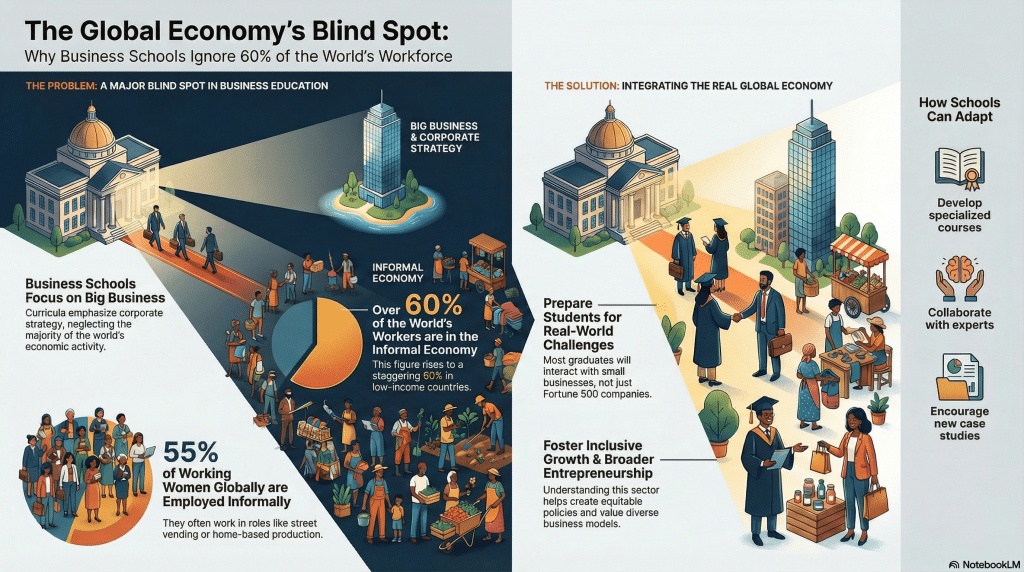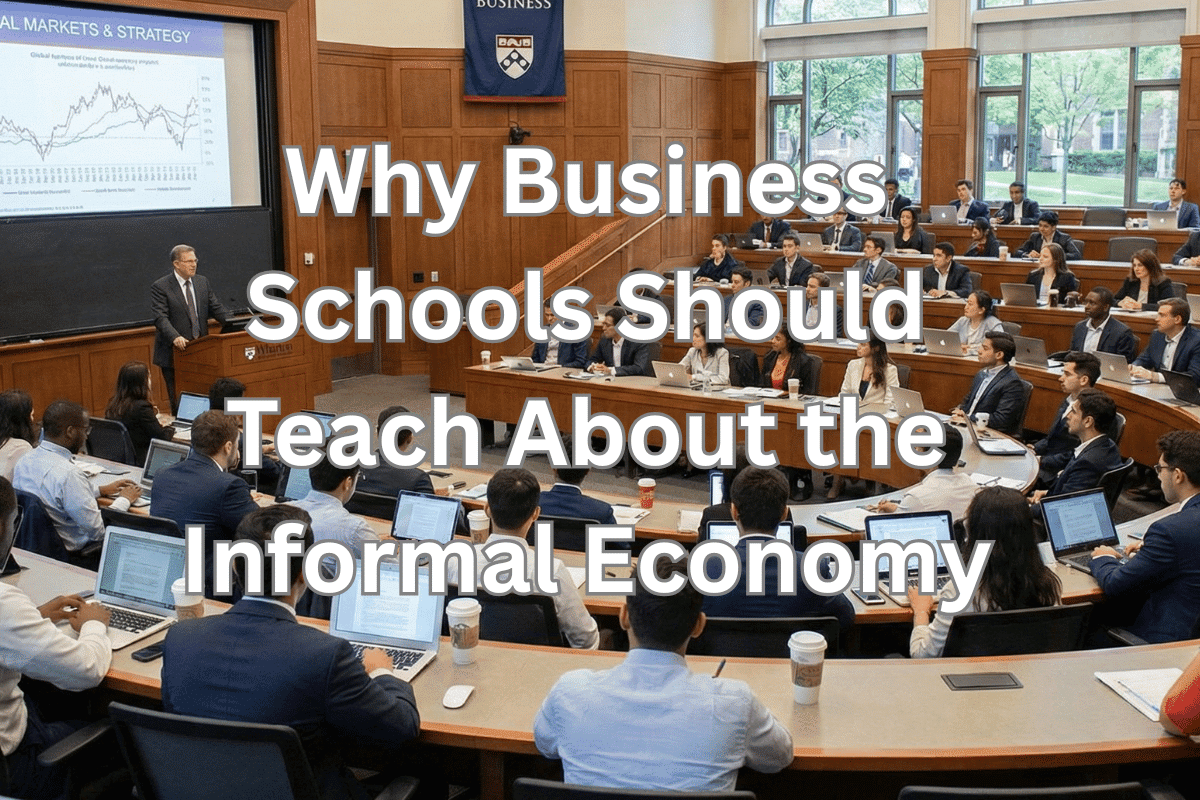Business education, particularly at the graduate level, is often geared toward preparing students to thrive in large corporations, multinational companies, or Fortune 500 organizations.
Business schools focus heavily on theories, strategies, and case studies related to big business, emphasizing corporate finance, global supply chains, and strategic management. While these topics are undoubtedly important, they leave a glaring gap in the curriculum: the informal economy.
Table of Contents
- The Current Focus of Business Schools
- The Scale and Importance of the Informal Economy
- Why Business Schools Should Teach About the Informal Economy
- What Should Be Taught About the Informal Economy?
- How Business Schools Can Implement This Change
- Deep Dive Podcast
- Related Questions
The informal economy, which encompasses all economic activities, enterprises, jobs, and workers not covered by formal regulations or protections, is a massive part of the global economy. It accounts for the livelihoods of billions of people worldwide, particularly in low- and middle-income countries.
Despite its scale and significance, the informal economy is rarely discussed in business schools, leaving students ill-prepared to understand or address the realities of this vital sector. This blog post will advocate for the inclusion of informal economy topics in business education to prepare future leaders for a more inclusive and equitable economy.

The Current Focus of Business Schools
Anyone who has attended a business school, especially at the master’s level, knows that much of the curriculum is designed with large businesses in mind. From courses on corporate strategy to global marketing, the focus is on preparing students to work in well-established, formal organizations.
This emphasis is also reflected in the hiring practices of universities, which often prefer faculty with experience in large corporations over those with backgrounds in small businesses or informal enterprises.
This approach neglects the fact that a significant portion of the global economy operates outside the formal sector. Many students, particularly international students from low- and middle-income countries, will return to regions where the informal economy dominates.
In these areas, 9 out of 10 workers are employed informally, and small businesses form the backbone of local economies. Even in developed countries, the informal economy exists, albeit on a smaller scale, in the form of gig work, freelance jobs, and unregistered businesses.
By focusing almost exclusively on large businesses, business schools fail to equip students with the knowledge and skills needed to navigate, understand, and contribute to the informal economy.
This gap in education is a missed opportunity to prepare future business leaders for the realities of the global workforce.

The Scale and Importance of the Informal Economy
To understand why the informal economy deserves a place in business education, it’s important to recognize its scale and significance. Here are some key statistics that highlight the importance of this sector:
Global Workforce:
Over 60% of the world’s employed population works in the informal economy. In low-income countries, this figure rises to 90%.
Women in the Workforce:
55% of working women globally are employed informally, often in roles such as domestic work, street vending, or home-based production.
Self-Employment:
Nearly 47% of informal workers are own-account workers, meaning they are self-employed individuals running one-person businesses without employees.
Economic Contribution:
The informal economy contributes significantly to national and global economies, providing goods, services, and livelihoods that are essential to society.
These statistics demonstrate that the informal economy is not a marginal or peripheral sector—it is a critical foundation for livelihoods, poverty reduction, and economic resilience worldwide.
Moreover, the informal economy is not limited to developing countries. In developed nations, informal employment exists in the form of gig work, independent contractors, and unregistered small businesses, making it a global phenomenon.

Why Business Schools Should Teach About the Informal Economy
I strongly advocate for business schools to include the informal economy in their curriculum, especially since such a significant portion of the world operates within this sector.
1. Preparing Students for Real-World Challenges
Most business school graduates will not end up working for Fortune 500 companies. Instead, many will work in or interact with small businesses, startups, or informal enterprises.
This is especially true for international students who return to their home countries, where the informal economy often dominates. By including the informal economy in the curriculum, business schools can better prepare students to address the challenges and opportunities they are likely to encounter in the real world.
For example, understanding how informal enterprises operate can help future business leaders develop inclusive policies, design products and services tailored to underserved markets, and create innovative solutions to support informal workers.
2. Fostering Inclusive Economic Development
The informal economy is a lifeline for billions of people, particularly in low-income countries. It provides jobs, generates income, and sustains local communities. However, informal workers and businesses often face significant challenges, including lack of legal protections, limited access to finance, and social stigma.
By teaching about the informal economy, business schools can inspire future leaders to advocate for inclusive economic development.
Students can learn how to design policies and programs that support informal workers, promote social equity, and address systemic inequalities. This knowledge is essential for creating a more inclusive and sustainable global economy.
3. Encouraging Entrepreneurship
Many informal workers are entrepreneurs, running small businesses or self-employed ventures to support themselves and their families. These entrepreneurs demonstrate incredible resourcefulness and resilience, often operating in challenging environments with limited resources.
Business schools often emphasize entrepreneurship, but the focus tends to be on high-growth startups or tech-driven ventures. Including the informal economy in the curriculum can broaden students’ understanding of entrepreneurship, highlighting the creativity and innovation of informal entrepreneurs.
This perspective can inspire students to think beyond traditional business models and explore new ways to create value.
4. Addressing Global Economic Trends
The informal economy is deeply intertwined with global economic trends, such as urbanization, migration, and digitalization. For example, the rise of the gig economy has blurred the lines between formal and informal employment, creating new challenges and opportunities for workers and businesses.
By teaching about the informal economy, business schools can help students understand these trends and their implications for the future of work. This knowledge is essential for navigating the complexities of the global economy and developing strategies that benefit both formal and informal sectors.
5. Promoting Sustainability
Informal workers, particularly waste pickers and recyclers, play a crucial role in promoting environmental sustainability. They recover and recycle materials that would otherwise end up in landfills, contributing to resource conservation and waste reduction.
Business schools often emphasize corporate social responsibility (CSR) and sustainability, but these discussions rarely include the informal economy.
By incorporating the informal economy into sustainability education, business schools can highlight the contributions of informal workers and inspire students to develop inclusive and sustainable business practices.
What Should Be Taught About the Informal Economy?
To effectively integrate the informal economy into business education, schools should design courses or modules that cover the following topics:
- Definition and Scope: Introduce students to the concept of the informal economy, its scale, and its significance in different regions and industries.
- Challenges and Opportunities: Explore the challenges faced by informal workers and businesses, as well as the opportunities for innovation and growth.
- Policy and Regulation: Discuss the role of governments, NGOs, and businesses in supporting the informal economy and promoting inclusive development.
- Case Studies: Use real-world examples to illustrate how informal enterprises operate and contribute to local and global economies.
- Entrepreneurship and Innovation: Highlight the creativity and resilience of informal entrepreneurs and the lessons they offer for business leaders.
- Sustainability and Social Impact: Examine the contributions of informal workers to environmental sustainability and social equity.

How Business Schools Can Implement This Change
1. Develop Specialized Courses
Business schools can create dedicated courses on the informal economy, covering topics such as informal entrepreneurship, inclusive business models, and sustainable development.
2. Incorporate Topics Into Existing Courses
Topics related to the informal economy can be integrated into existing courses on entrepreneurship, sustainability, and global business.
3. Collaborate with Experts
Business schools can collaborate with NGOs, policymakers, and informal economy experts to provide students with practical insights and real-world perspectives.
4. Encourage Research and Case Studies
Schools can encourage faculty and students to conduct research on the informal economy and develop case studies that highlight its importance.
The informal economy is a massive and essential part of the global economy, providing livelihoods, goods, and services to billions of people. Yet, it remains largely ignored in business education, which focuses primarily on preparing students for careers in large corporations.
This gap in education leaves students ill-equipped to understand or address the realities of the informal economy, limiting their ability to contribute to inclusive and sustainable economic development.
By incorporating the informal economy into their curricula, business schools can prepare future leaders to navigate the complexities of the global economy, promote social equity, and support the billions of people who depend on informal work. It’s time for business education to move beyond its corporate focus and embrace the diversity and dynamism of the informal economy.
Deep Dive Podcast
Learn more with our Deep Dive Podcast.
At A Bus On A Dusty Road, we talk about travel, life, and ex-pat living. We are all about “Living Life As A Global Citizen.” We explore social, cultural, and economic issues and travel.
We would love to have you be part of our community. Sign up for our newsletter to keep up-to-date by clicking here. If you have any questions, you can contact me, Anita, by clicking here.
Listen to our Podcast called Dusty Roads. You can find it on all major podcast platforms. Try out listening to one of our podcasts by clicking here.
Subscribe to our A Bus On A Dusty Road YouTube Channel with great videos and information by clicking here.
Related Questions
Is A Day Trip To The Grand Canyon Worth It?
If you only have one day to visit the Grand Canyon, it is still worth visiting. You can do things to prepare for your trip so that you will have the most time available. We recommend you go to see the South Rim area of the Canyon.
By clicking here, you can discover Is A Day Trip To The Grand Canyon Worth It?.
How Much Time Should We Plan To Spend At The Grand Canyon?
The Grand Canyon was once filled with water, but the Grand Canyon itself is at least 6 million years old. The rock and rock formations of the Grand Canyon help us to tell the story of this magnificent place on earth.
By clicking here, you can discover How Much Time Should We Plan To Spend At The Grand Canyon?.
Was The Grand Canyon Once Totally Filled With Water? & More
The Grand Canyon was once filled with water, but the Grand Canyon itself is at least 6 million years old. The rock and rock formations of the Grand Canyon help us to tell the story of this magnificent place on earth.
By clicking here, you can discover Was The Grand Canyon Once Totally Filled With Water? & More.

